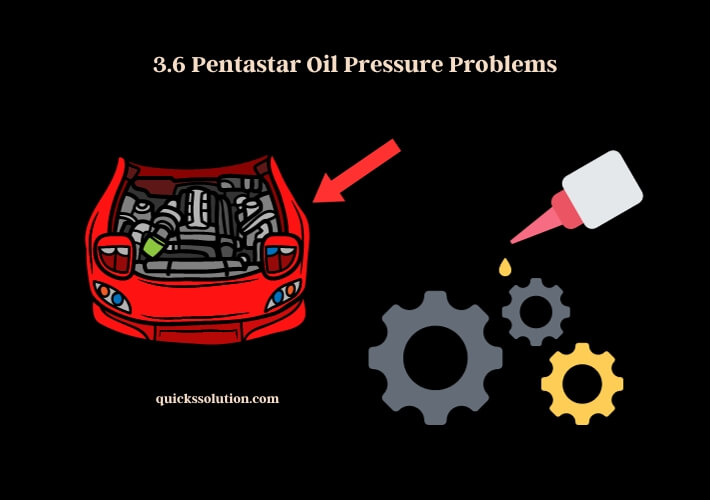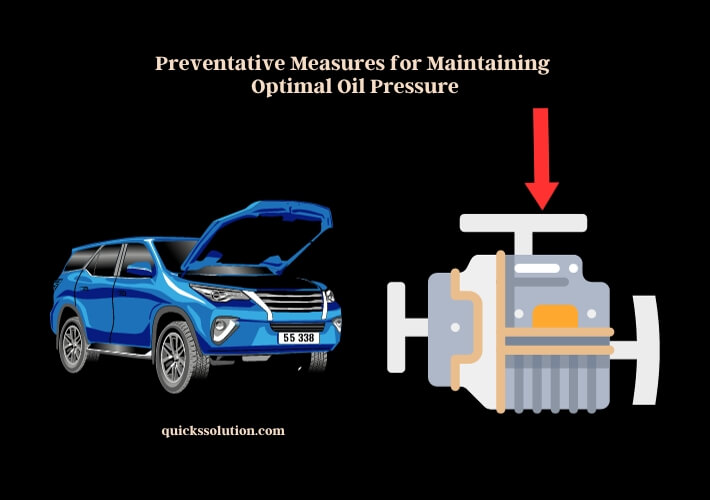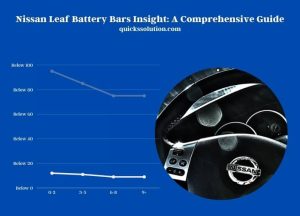Published on: October 11, 2023
Written by Amlan Roy / Fact-checked by Hashim Manna
The 3.6 Pentastar engine sometimes faces oil pressure issues. These problems can manifest in various ways, affecting the performance and longevity of the engine.
The 3.6 Pentastar engine, commonly found in Dodge and Ram 1500 vehicles, has been noted for certain oil pressure concerns. At idle, some users have reported fluctuations in oil pressure, which can be a cause for concern. The oil pressure relief valve plays a crucial role in regulating the oil pressure within the engine.
If this valve malfunctions, it can lead to either high or low oil pressure, both of which can be detrimental to the engine’s health. For those looking to monitor or address these issues, the oil pressure sensor is a key component to be aware of. Its location is vital for mechanics and DIY enthusiasts aiming to troubleshoot or replace it.

In some instances, especially in Dodge vehicles, low oil pressure warnings have been observed. On the other hand, there have been instances where the 3.6 Pentastar showcased high oil pressure, which is equally concerning. Regular maintenance and timely checks can help in ensuring that the engine runs smoothly and any potential oil pressure issues are addressed promptly.
Background of the 3.6 Pentastar Engine
Brief history and models using this engine
The 3.6 Pentastar engine, a product of Chrysler’s innovative engineering, has been a significant player in the automotive world for years. Born out of a need to streamline the V6 engine portfolio, the 3.6 Pentastar emerged as a versatile powerhouse. Over time, it has found its way into various vehicles, from sleek sedans to rugged trucks, proving its adaptability. Its integration across different models highlights its reliability and performance capabilities, making it a favorite among many automotive enthusiasts.
Engine specifications and general performance
Diving into the nitty-gritty, the 3.6 Pentastar is a marvel of modern engineering. This V6 engine, with its 3.6-liter displacement, strikes a balance between raw power and fuel efficiency. Its aluminum block construction ensures it remains lightweight, aiding in better fuel consumption. The 24-valve design optimizes airflow, ensuring that the engine breathes efficiently, translating to better combustion and performance. Its design and build quality have made it a staple in many vehicles, promising durability and consistent performance.
Basics of Oil Pressure in Engines
Role of oil in engine performance
Oil in an engine is like blood in our veins. It serves multiple purposes, from lubricating moving parts to ensuring the engine remains cool during operation. Without the right amount and quality of oil, engines would face increased friction, leading to premature wear and tear. Moreover, oil plays a pivotal role in heat dissipation. As engines run, they generate heat, and it’s the oil’s job to absorb this heat and help in cooling, ensuring the engine doesn’t overheat.
Ideal oil pressure range for optimal engine health
Every engine has its sweet spot for oil pressure, a range where it operates at its best. For the 3.6 Pentastar, this range is typically between 20 to 30 psi when idling. Maintaining this optimal range ensures that there’s enough oil circulating throughout the engine, providing lubrication and cooling. Think of it as maintaining the right water pressure in your home’s plumbing system; too high or too low can lead to problems.
Common Symptoms of Oil Pressure Problems
Fluctuating oil pressure readings
Consistent oil pressure is crucial for the engine’s health. If you’re observing erratic readings, it’s a red flag. These fluctuations can be due to various reasons, from a malfunctioning oil pump to blockages in the oil pathways. It’s akin to a heart’s inconsistent heartbeat; it indicates underlying issues that need attention.
Warning lights and alarms in the dashboard
The dashboard serves as the communication hub of your vehicle. If the oil pressure light is illuminated, it’s signaling potential issues. While sometimes it might be a minor sensor glitch, it’s always wise to investigate further. Ignoring such warnings can lead to more significant problems down the road.
Unusual engine noises
A healthy engine has a distinct, smooth sound. If you start hearing abnormal noises like knocks or rattles, it’s a sign of trouble. These sounds often indicate increased friction between engine parts, suggesting that the oil isn’t lubricating as it should.
Causes of Oil Pressure Issues in the 3.6 Pentastar
Malfunctioning oil pressure relief valve
The oil pressure relief valve acts as a regulator, ensuring the oil pressure doesn’t exceed safe limits. If this valve isn’t functioning correctly, it can lead to excessively high oil pressure, which can damage engine components. It’s like having a faulty regulator on a gas cylinder; the results can be catastrophic.
Faulty oil pressure sensor
The oil pressure sensor is the watchdog of the engine’s oil system. It monitors and reports the oil pressure in real-time. If it’s malfunctioning, it can give incorrect readings, leading to either undue concern or neglect of a genuine issue.
Blockages in oil pathways
Over time, impurities, sludge, and debris can accumulate in the engine’s oil pathways. These blockages can restrict the flow of oil, leading to reduced pressure. It’s similar to how cholesterol can block human arteries, impeding blood flow and leading to health issues.
Reported Oil Pressure Issues by Model and Year
| Model | Year | Reported Issues |
|---|---|---|
| Dodge Challenger | 2020 | High oil pressure |
| Ram 1500 | 2019 | Low oil pressure at idle |
| Dodge Charger | 2018 | Fluctuating oil pressure readings |
Solutions and Fixes for Oil Pressure Problems
Replacing the oil pressure relief valve
If the relief valve is malfunctioning, it’s imperative to address it immediately. Replacing a faulty valve can often rectify oil pressure issues. It ensures that the oil circulates at the right pressure, safeguarding the engine’s health.
Locating and addressing the oil pressure sensor
If the oil pressure readings seem off, the sensor might be the culprit. It’s essential to locate it, test its functionality, and if found faulty, replace it. A functioning sensor ensures you get accurate readings, allowing you to address any issues promptly.
Cleaning or replacing oil pathways
If blockages are causing the oil pressure issues, the pathways need attention. Cleaning them can often restore normal oil flow. In extreme cases, some pathways might need replacement to ensure the engine gets its lifeblood without hindrance.
Step-by-Step Infographic: Troubleshooting Oil Pressure Issues
Step 1:
Gather the necessary tools and ensure safety precautions.
Step 2:
Check the oil level and quality. If the oil is dirty or below the required level, consider changing it.
Step 3:
Inspect the relief valve for any signs of malfunction. Replace if necessary.
Step 4:
Locate and test the oil pressure sensor. Replace if it’s giving incorrect readings.
Step 5:
Check for blockages in the oil pathways. Clean or replace as needed.
Preventative Measures for Maintaining Optimal Oil Pressure

Regular engine checks and maintenance
Routine maintenance is the first line of defense against oil pressure problems. Regularly checking the oil level, quality, and changing it at recommended intervals ensures the engine remains in peak condition.
Importance of using the right oil grade
Not all oils are created equal. Using the recommended oil grade for the 3.6 Pentastar ensures optimal performance. It’s like giving the engine the right kind of nutrition it needs to function efficiently.
Tips for ensuring engine longevity
To ensure the 3.6 Pentastar serves you for years, regular maintenance is key. Along with oil checks, ensure other components like the oil pump, filter, and pathways are in good condition. Listen to your engine; often, it will tell you when something’s amiss.
FAQs
What Are the Common Symptoms of 3.6 Pentastar Oil Pressure Problems?
One of the first signs of oil pressure problems in the 3.6 Pentastar engine is fluctuating oil pressure readings. This inconsistency can be alarming. Another symptom is the illumination of warning lights or alarms on the dashboard, signaling potential issues. Additionally, unusual engine noises, such as knocking or grinding sounds, can indicate that the oil isn’t lubricating as it should, leading to increased friction between engine parts.
How Does the 3.6 Pentastar Engine Maintain Optimal Oil Pressure?
The 3.6 Pentastar engine relies on a combination of components to maintain the right oil pressure. The oil pump ensures that oil circulates throughout the engine, while the oil pressure relief valve acts as a regulator, preventing the pressure from getting too high. The oil pathways, free from blockages, allow for smooth oil flow, ensuring that every part of the engine receives adequate lubrication.
Are Water Pump Issues Related to Oil Pressure Problems in the 3.6 Pentastar Engine?
Water pump issues in the 3.6 Pentastar engine can indeed be related to oil pressure problems. The pentastar water pump issues may result in coolant leaks, causing overheating and potential engine damage. A faulty water pump can disturb the flow of coolant, impacting the engine’s overall performance and leading to oil pressure irregularities. Regular maintenance and prompt detection of these issues are crucial to avoid costly repairs.
What are the Common Signs of Oil Pressure Problems in a 3.6 Pentastar engine?
If you have noticed oil pressure warning lights, oil leaks, or loud knocking sounds coming from your Pentastar 3.6 engine, it could indicate oil pressure problems. It’s essential to check your vehicle’s Pentastar 3.6 oil quart requirement and address any issues promptly to prevent engine damage.
Why Is the Oil Pressure Sensor Crucial for the 3.6 Pentastar Engine?
The oil pressure sensor plays a pivotal role in monitoring and reporting the real-time oil pressure in the engine. If this sensor malfunctions, it can provide incorrect readings, leading either to undue concern or neglect of a genuine issue. Keeping this sensor in good working condition ensures that you receive accurate information about the engine’s oil pressure, allowing for timely interventions if problems arise.
What Role Does the Oil Pressure Relief Valve Play?
The oil pressure relief valve in the 3.6 Pentastar engine acts as a safety mechanism. Its primary function is to ensure that the oil pressure doesn’t exceed safe limits. If this valve malfunctions, it can lead to excessively high oil pressure, which can, in turn, damage various engine components. Ensuring that this valve is in good working condition is essential for the overall health of the engine.
How Can Blockages in Oil Pathways Impact the 3.6 Pentastar Engine?
Blockages in the oil pathways can have a detrimental effect on the 3.6 Pentastar engine. Over time, impurities, sludge, and debris can accumulate in these pathways. These blockages can restrict the flow of oil, leading to reduced pressure. This can result in inadequate lubrication of engine parts, increased friction, and potential engine damage. Regular cleaning or replacement of these pathways can prevent such issues.
What Are the Preventative Measures for Maintaining Optimal Oil Pressure?
To ensure the 3.6 Pentastar engine maintains optimal oil pressure, regular engine checks and maintenance are crucial. Checking the oil level and quality at regular intervals, using the recommended oil grade, and ensuring other components like the oil pump and filter are in good condition are some of the steps one can take. Listening to your engine and addressing any unusual sounds or behaviors promptly can also help in early detection and resolution of potential problems.
Are There Any Known Recalls or Issues Related to Oil Pressure in the 3.6 Pentastar?
While the 3.6 Pentastar is a reliable engine, like all mechanical components, it can have its issues. There have been instances where owners have reported oil pressure problems. However, it’s always recommended to check with the vehicle manufacturer or authorized service centers for any recalls or service bulletins related to oil pressure or any other concerns specific to the 3.6 Pentastar engine.
The 3.6 Pentastar engine, with its blend of power and efficiency, has won many hearts. But like all machines, it has its quirks. Oil pressure problems, if left unchecked, can lead to severe issues. By understanding the symptoms, causes, and solutions, and by adopting a proactive maintenance approach, you can ensure that your engine remains in top-notch condition for years to come. After all, a little care goes a long way!




